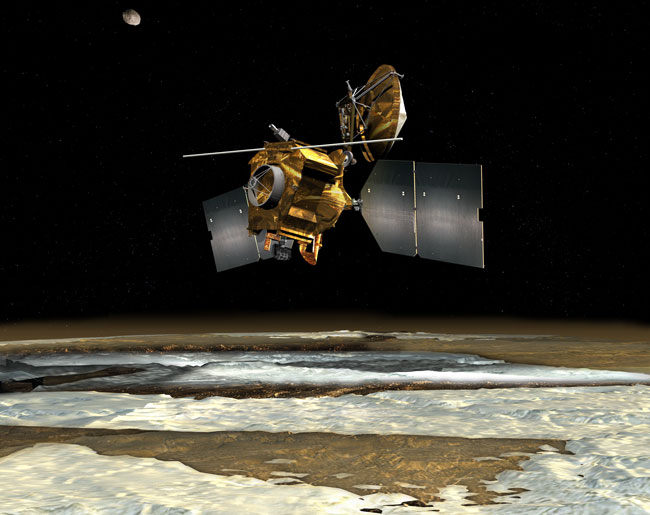Hello Mars, Meet 'MR. O': The Mars Reconnaissance Orbiter

DENVER, Colo. -- The Mars Reconnaissance Orbiter is one giant spacecraft, built to take unprecedented photos of the red planet. Engineers are in test time mode here at Lockheed Martin Space Systems, builder of the spacecraft, as the countdown ticks down for the probe's summer launch.
Teams of technicians now swarm around the spacecraft as it enters the final four months of system and environmental tests. The checklist calls for the Mars-bound craft to be "out the door" of the aerospace company in April and en route to Florida.
Sent Marsward atop an Atlas 5 booster, the Mars Reconnaissance Orbiter (MRO) will tip the scales at 4,796 lbs (2,180 kilograms) at liftoff.
Brimming with science instruments -- rooted to a potent chassis of electronic, propulsion, and mechanical gear -- MRO will be the largest spacecraft to orbit the red planet. Science gleaned from this mission is expected to dramatically expand our knowledge of Mars.
Let's get intense
"We call it 'Mr. O'", said Jim Graf, Project Manager for MRO at NASA's Jet Propulsion Laboratory (JPL) in Pasadena, California. "It's an amazing piece of hardware. The time is right for it...it just has such capability," he told SPACE.com during a recent inspection of the interplanetary spacecraft.
Less than two years from now, MRO is tasked to start a series of global mapping, regional survey and targeted observations from a near-polar, low-altitude Mars orbit. It will fly closer to the martian surface than any other orbiter has ever gone.
Breaking space news, the latest updates on rocket launches, skywatching events and more!
MRO is equipped with six primary instruments: the High Resolution Imaging Science Experiment, Context Camera, Mars Color Imager, Compact Reconnaissance Imaging Spectrometer for Mars, Mars Climate Sounder and Shallow Radar. The orbiter will also carry a telecommunications relay package and two engineering demonstrations.
The road to Mars for MRO has not been without difficulty.
"The development of the instruments...they are all state-of-the-art," Graf said. "They are brand new instruments. So that has been one of the biggest challenges."
Graf said that MRO is an unprecedented workhorse of a spacecraft. Given its memory storage and computer smarts, as well as the probe's telecommunications package and power capability, "it's the cornerstone of the future Mars program," he said.
MRO carries a large set of solar arrays and a huge high gain antenna. "It's wonderful isn't it," Graf said, pointing to the dish antenna that measures some 10-feet (3 meters) in diameter -- hardware that will enable the craft to pump out enormous streams of information back to Earth from Mars orbit.
"We're going to be awash in data. There's no doubt about it," Graf added. "Let's get intense...start an investigation of the planet in a mode that's entirely different than anything we've done before."
Test like you fly
MRO has moved into a "robust pace" of testing, said Kevin McNeill, MRO program manager at Lockheed Martin Space Systems.
The spacecraft has undergone an acoustic simulation of its Atlas 5 ride into space. Solar array and high gain antenna test deployments were near at hand. Among other key milestones, exposure of MRO to thermal and vacuum conditions that imitate the real deal of trekking through space to Mars was slated for next month.
"When you do the environmental testing, you want to follow the environments that you'll see in the actual sequence of flight," McNeill said. "You want to test like you fly."
Located just a few buildings away from where MRO is undergoing evaluation, Lockheed Martin rocketeers are assembling and testing the Atlas 5 launch vehicle -- designated AV-007 -- that will toss the spacecraft onward to the red planet.
The booster will be shipped to Cape Canaveral, Florida in March with MRO sent to the spaceport on April 29th, McNeill said, with liftoff scheduled for August 10th as target date in a 20-day launch window.
Sure to find surprises
At Mars, MRO observations will be unmatched in terms of the spatial resolution and coverage achieved by the orbiter's instruments.
"In the Mars exploration program, we've adopted a 'follow the water' strategy...and our MRO mission is part of that," said JPL's Rich Zurek, MRO project scientist. "This orbiter is very much following up on the very recent discoveries," he said, noting the findings of the still-going-strong Mars rovers, Spirit and Opportunity.
Zurek said MRO is booked with early work at the start of a five-and-a-half year agenda.
For one, MRO will scope out a landing site for NASA's Phoenix lander. That mission is to land in the northern polar region of Mars in May 2008. Once on the surface, the stationary lander is to use its robotic arm to expose the upper few feet of surface material in a search for ice.
One of the first things on MRO's priority list is to scan possible Phoenix lander sites for any hazards. MRO radar and sounder readings will also be taken, with the data assembled surely to be helpful in picking the right Phoenix landing spot. "They want to make sure it's safe and we're going to help certify that site for them," Zurek told SPACE.com.
Similarly, locating the Mars Science Laboratory's touchdown zone in October 2010 is another priority, Zurek noted, with MRO able to find the best place on Mars for the greatest scientific return from that highly capable rover.
MRO cameras to zoom in for extreme close-up photography of the martian surface; utilize a sounder to find subsurface water; and look for safe and scientifically worthy landing sites for future exploration - Zurek said that the interplanetary craft is ready for action.
"We're sure to find surprises," Zurek said. Each spacecraft that has traveled to Mars, and each time the planet has been eyed with greater resolution or in a new part of the electromagnetic spectrum, he added, the red planet has conveyed a message: "No...I'm not the way you thought I was."

Leonard David is an award-winning space journalist who has been reporting on space activities for more than 50 years. Currently writing as Space.com's Space Insider Columnist among his other projects, Leonard has authored numerous books on space exploration, Mars missions and more, with his latest being "Moon Rush: The New Space Race" published in 2019 by National Geographic. He also wrote "Mars: Our Future on the Red Planet" released in 2016 by National Geographic. Leonard has served as a correspondent for SpaceNews, Scientific American and Aerospace America for the AIAA. He has received many awards, including the first Ordway Award for Sustained Excellence in Spaceflight History in 2015 at the AAS Wernher von Braun Memorial Symposium. You can find out Leonard's latest project at his website and on Twitter.
